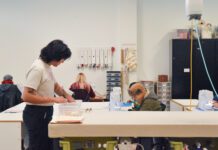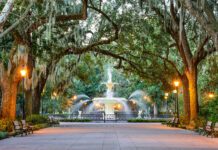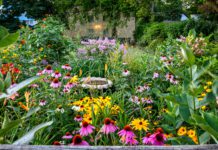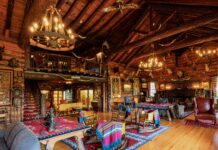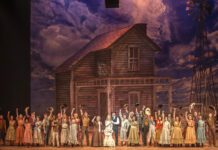Keeping A Legacy
Osiyo.
Ha’-We.
Chokma.
Of the 38 federally recognized tribes in Oklahoma, these are three – Cherokee, Osage, Chickasaw – of their indigenous greetings. To ensure future generations won’t ever have to say goodbye to their history, culture and language, many tribes have launched meticulous preservation efforts.
These efforts include teaching, archaeology, archiving, renovation – and a lot of persistence. Currently, 566 federally recognized tribes exist in the United States, though full-blooded Native Americans (and Alaska Natives) compose only 1.2 percent of the population, per 2012 Census Bureau estimates. In the wake of conventional American society, instructing new generations about their distinctive heritage and culture is more important than ever.
Text me in Cherokee
The Cherokee Nation, spread out like a blanket among 14 counties in northeast Oklahoma, comprises the largest tribe in the U.S.
Cherokee is a word that has been spelled many ways and has been infused with many possible meanings and origins. Currently, Cherokees call themselves Aniyvwiya, which translates to the “Real People.”
These Native Americans never lived in teepees; instead, Cherokee dwellings were historically houses created of mud and clay with roofs of brush and river cane. By the 1700s, many Cherokees lived in log cabins and even clapboard houses.
In the early 1800s, Cherokee statesman Sequoyah developed the first written language of any Native American tribe. The Cherokees “come from a rich tradition of innovators,” says Principal Chief Bill John Baker.
“We published a newspaper, written in both Cherokee and English,” Baker says. “We created a legislature and a strong sense of self-governance that persists today.”
To protect the Cherokee language, the tribe has kept pace with new technology. “We have worked with Apple to incorporate our language into the operating systems for Macs, iPods, iPhones and iPads,” Baker says. In the past year, Cherokee also was integrated into Windows 8 and Gmail.
“Our Cherokee children can text faster than they can speak oftentimes, and entirely in Cherokee,” says Baker. “To watch them use their native language on modern devices is really something to see.”
The nation created the Cherokee Language Immersion School to teach children how to speak this well-developed tongue. “Beginning in kindergarten and advancing through the sixth grade, children speak, read and write their lessons, only in Cherokee,” Baker says. “It’s amazing to watch our young people grow up bilingual.”
In addition to preserving its language, the tribe has preserved its historic buildings. One such is the 1844 Cherokee Nation Supreme Court building, the oldest government building in Oklahoma.
Back then, the building housed the tribe’s Supreme and District courts; it also held the printing press for the Cherokee Advocate (now called the Phoenix), the official publication of the tribe and the first newspaper in Oklahoma. The historic building is now a museum that educates future generations about the Cherokee judicial system, language and newspapers.
The tribe’s most recent projects include renovation of the Cherokee National Capital, which currently houses the judicial branch of government, and the Cherokee National Prison, according to Baker.
Four themed tours – Cherokee History Tour, Cherokee Old Settler Tour, Civil War History Tour and Will Rogers History Tour – help people explore their cultural heritage at historic sites. In the program’s first year, 1,700 people took these tours, says Baker.
Tours are offered every Saturday to the general public.
Imparting The Arts
The Osage Nation, composed of Wah-Zha-Zhi people originally known as “Children of the Middle Waters,” is headquartered in Pawhuska, the heart of Oklahoma’s largest county – Osage. During historic times of war, the Osage were feared as tall, fierce warriors by neighboring tribes. They were highly ranked among the old hunting tribes of the Great Plains. However, as hunter-farmers, the Osage people did not conform exactly to the lifeways of either woodland or plains tribes.
The Osage Nation became the only (at the time) American Indian nation to purchase its reservation in 1870. Today, the Osage is preserving its customs and art forms through the Osage Cultural Center, which opened in 2004. Vann Bighorse, who became the Pawhuska center’s director in 2007, says he is proud of his tribe for being able to assert its sovereignty in 2006. At that time, the tribe established a constitution with a three-branch form of government, which is in place today.
The 2006 Osage constitution “opened the door” for culture and language preservation, says Bighorse. “They created a language and cultural department with the vision to teach Osage people and the community about our tribal ways of life,” he says. “Since then, that’s what we’ve been doing.”
From fall through spring, the cultural center holds free cultural art and traditions workshops and lectures. Here, Osages can learn how to create “our clothing and other intricate art forms that were getting to be very much endangered,” says Bighorse.
Fingerweaving classes teach the tricky but beautiful art of hand-weaving more than a hundred strands of dyed yarn (buffalo hair was used in “the old days on the prairie,” says Bighorse) into a patterned belt. Some classes teach the history and ceremony of the Osage woven baby board. Still others teach the art of ribbon work, where ribbons in “traditional Osage colors” of turquoise, purple, green and red are cut and folded into patterns.
Workshops also instruct people on how to make Osage moccasins and headdresses. The center has generated a lot of interest and classes fill up fast, Bighorse says. All the materials are provided by the center, and participants are able to keep their finished products.
For the past four years, the Osage Nation has also held an annual cultural walk, which commemorates the tribe’s movement from Kansas to Oklahoma, “to the reservation here,” Bighorse says.
This year, the Osage Nation Tribal Museum Library and Archives celebrated its 75th anniversary. Established in May 1938, it is the oldest tribe-owned museum.
Though the center slows its schedule during the summer months – to focus on Osage ceremonial dances – they’ll gear up again in fall to keep their tribe’s art forms and lifeways alive for generations to come.
Archiving And Thriving
The Chickasaw, one of the last tribes to move during the “Great Removal,” have called south-central Oklahoma its homeland since the mid-1800s. Historically, the Chickasaw people – one of the Five Civilized Tribes – were revered as “Spartans of the Lower Mississippi Valley.”
This tribe of “unconquered and unconquerable” warriors lived an agrarian lifestyle in sophisticated towns with a highly developed ruling system, laws and religion. Chickasaws built some of the first schools, banks and businesses in Indian Territory.
Chickasaw people have relied on oral storytelling to pass down their history, culture, beliefs and traditions through generations. Their legends explain natural phenomena, describe one’s place in the universe and encourage virtues. Chickasaw elders believe passing on ancient knowledge was and is a sacred obligation.
One important legend tells about the beginning of the Chickasaw people, and how they found homelands in the Mississippi River Valley with the help of a big white dog and a sacred pole. Another tale, called No Lost Children, speaks of the Chickasaw children’s knowledge and surefootedness in the wilderness.
The Chickasaw Nation Archives is where these stories and other documentary materials are collected and maintained to preserve tribal history. The archives keeps – and accepts – a vast array of photographs, film, slides, negatives, microfiche, video and other documents related to Chickasaw research, achievements, arts and language. Some of the archives are kept in the Chickasaw Nation Library in Ada; other archives are stored at Holisso: the Center for Study of Chickasaw History and Culture.
This new research center is on the sprawling campus of the Chickasaw Cultural Center in Sulphur. The center focuses on the study, scholarship and research of Chickasaw and southeastern tribal cultures and histories. The Holisso Center features state-of-the-art artifacts storage, a library reading room and a rare book collection. The center also hosts genealogy and oral history workshops, educational spotlights, digitization events, lecture series, conferences and book signings.
One Chickasaw artist and historian, Jeannie Barbour, recently completed the final drawings for a three-book series about the history and stories of the tribe.
The first book is called Chickasha Stories, Volume One: Shared Spirit; the second is Chickasha Stories: Shared Voices; the third installment, Chickasha Stories: Shared Wisdom, was sent to the printer in early July.
The stories were compiled by Chickasaw storyteller and tribal elder Glenda Galvan, who graciously agreed to write down the vital tales. “Normally, oral tradition – particularly for traditionalists like Glenda – requires that (stories) be spoken orally,” Barbour says. “You don’t ever write them down. Most tribes sort of hold to that rule.”
When a tribe loses an elder, “you lose a lot,” Barbour says. “Especially if they were language speakers. There was a concern we were losing too many of these stories. So it was decided maybe we should write them down.”
These ancient stories are important teaching tools for new generations of Chickasaws. “I believe the stories are just as meaningful today as what they were 200, 300 or 500 years ago,” Barbour says. “They are very old and they’ve been passed down all this time with a purpose.”
Barbour has studied the tribe’s history and culture for the past 25 years.
Protecting The Sacred
Most Oklahoma tribes have made cultural preservation a priority. Due to their history of forced removals by the U.S. government, many tribes have diligently focused on retracing their movements across America, while marking, honoring (or repatriating) their cemeteries, funerary objects and other sacred sites. One of the most unique and valuable parts of each tribe’s culture is its language. Not all tribes have language programs as advanced as the Cherokee Nation’s, but most tribes strive to sustain their native tongue. Every tribe has an intricate universe of beliefs and beauty and ideas about life. And that’s worth holding onto.
Hollywood Bound
Samantha Isler knows a little something about being on stage and camera. After all, the 15-year-old Oklahoman began performing for her family as a small child before honing her skills in theatrical stage productions. Parlaying talent and experience, Isler went on to appear in several short and feature films. This fall, she will be welcomed into the homes of many Americans, co-starring in NBC’s Sean Saves the World alongside Sean Hayes (Will & Grace), Linda Lavin (Alice) and Megan Hilty (Smash), among others. The comedy centers on a father (Hayes) who must catch up to speed when his teen daughter (Isler) moves in. Sean Saves the World premieres on Oct. 3.
Oklahoma Magazine: When did you know that you wanted to be an actress?
Samantha Isler: Growing up, I always was doing skits around the house, and I watched and enjoyed movies. It took a while to realize that these were all individual men and women acting, and I thought it was fun. I began taking classes, made contacts and here I am now. I always knew I wanted to act – it just took a while to figure it out.
OM: What do you consider to be your big break so far?
SI: Probably when I did the film, Home Run. It was a small role, but it was on the big screen, and I got to be in the acting environment and learn a lot.
OM: How did this role come about, and how did you feel when it happened?
SI: Initially, I was asked to audition – I had met the casting director previously. I sent a videotape; I didn’t even audition in person. About three hours later, I got a call and they wanted me to do a screen test. A couple of weeks later, I went out for the screen test and met the writers. They called a little later to say that I had gotten the role. It was great. I was familiar with the people in the show because I watch them. As the process went on, I realized what could happen and tried to process and manage my excitement – and I still am.
OM: What do you think of your co-stars?
SI: They are all so great, and I was amazed that these were all people who I had watched. At first, I was nervous working with such experienced actors. But they helped me a lot and I am learning a lot. It’s okay for me to forget a line or to accidentally laugh at one of my co-stars. They have been so helpful and made me feel more confident.
OM: How does your acting work affect school?
SI: I went to private school through the eighth grade. This year, I will be doing home schooling in California. It will be different, but I will be able to maintain my grades that way…but it will be different.
OM: Where would you like to see your career go from here?
SI: Before I did this show, I did a few films, and I love that as well. I would like to do different things, to experience all of the different types of acting and genres.
Born To Serve
Like many teenagers who grew up in the ‘50s, Neal McCaleb had a summer job, but his was a little bit different than most. He spent his summers working with highway engineers.
“My dad was with the highway department for all of his adult career,” recalls McCaleb. “So I was raised around the concept of public service, and he involved me in what he was doing. He took me on what the engineers called plan hands, when they took the preliminary plans into the field and tried to verify them. So I got to run around with him and the other highway engineers, and I grew to appreciate what they were doing. I started my career in highways at the age of 16 when I went to work for a small bridge contractor.”
Those early experiences led McCaleb to return each summer to work with the highway department, and ultimately, to Oklahoma A&M College, where he graduated in 1957 with a civil engineering degree. The year before, the interstate highway system had been approved by Congress. Some college grads may not know exactly what they want to do after graduation; for McCaleb, the choice couldn’t have been any clearer.
“I went right to work consulting with the same firm, working on the development of the designs and construction plans for the interstate. I did that for two years and then had an opportunity to go to work for the City of Oklahoma City in the engineering department, which involved more personal contact with users.”
The personal contact McCaleb enjoyed from his time there would become a hallmark for the work ahead of him. After two years with the City of Oklahoma City, McCaleb left to start a private consulting firm and ultimately a side business developing and building residential subdivisions in the area. But the idea of public service was always on his mind.
“I’ve always had an appetite for public service,” McCaleb says. “I served in the legislature; I was elected in 1974, began service in 1975 and served eight years in the Oklahoma House of Representatives, half that time as the Republican floor leader.”
McCaleb returned to public service in 1987, serving as Oklahoma’s first Secretary of Transportation under Gov. Henry Bellmon, a position he would fill again in 1995 under Gov. Frank Keating. He left that position in 2001 when President George W. Bush appointed him as Assistant Secretary of the Interior. After leaving government service in 2003, McCaleb became a special advisor to Chickasaw Nation Governor Bill Anoatubby, ultimately assuming the position of Ambassador at Large for the Chickasaw Nation, following the death of Ambassador Charles Blackwell earlier this year.
“The role is just really beginning to develop,” McCaleb says, “I’m still doing a lot of the same things I did before. I’m in contact with various government agencies, including the Department of Transportation, and on the federal level as well.”
McCaleb serves as Chairman of the Board of Chickasaw Nation Industries, while also serving as a board member of Chickasaw’s wholly owned bank, Bank 2.
“I’ve enjoyed my service everywhere I’ve been,” McCaleb says, “And there’s always more to be done.”
Powwow Time
It’s powwow time! Anyone who has attended a powwow in the past knows there are a few rules to follow. First, you do not enter the dance circle unless you’re a dancer or invited in. Second, be sure to bring your own bottle of honey for fry bread in case the concession stand runs out. Actually, there is a third rule, and that is to have fun, something always encouraged at the Intertribal Indian Club of Tulsa’s Powwow of Champions. The 36th annual festival of Native American art, dance, food and music will be Friday, Aug. 9-Sunday, Aug. 11, at the Mabee Center, 7777 S. Lewis Ave., Tulsa. Admission is $7-$15 at the door. Visit www.iicot.org for schedules and more details. Looking for more? Check out the Oklahoma Indian Nations Powwow in Concho Aug. 2-4; the Choctaw Nation Labor Day Festival & Powwow in Tuskahoma from Aug. 29-Sept. 2; the Cherokee National Holiday in Tahlequah from Aug. 30-Sept. 1; and the Ottawa Powwow & Celebration, Aug. 30-Sept. 1, in Miami.
A Destination In Limbo
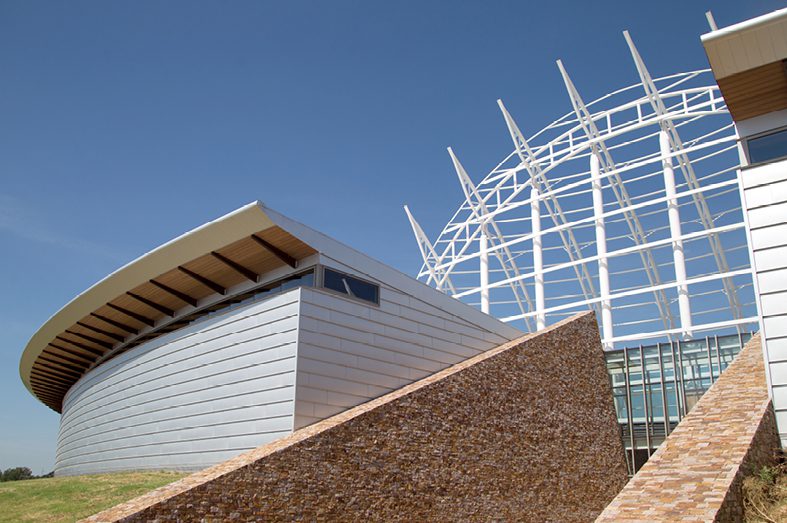
In 1986, the Oklahoma State Department of Tourism and Recreation kicked off a quiet, largely unnoticed exploration of opportunities to pump up the state’s then-lackluster economy by boosting tourism. Its final conclusion – unsurprising at best, completely obvious at worst – pointed right at Oklahoma’s rich and textured American Indian culture as something that might pull in a lot of paying customers. Almost 30 years later, the very bold and loud answer to that first, quiet question sits along the Oklahoma River just south of Oklahoma City’s central business district. The American Indian Cultural Center and Museum (AICCM) is a world-class steel, glass and concrete tribute to the culture, art and history of Oklahoma’s 39 tribes. It’s also unfinished.
Over the years of its planning and development, the Center has morphed into something far bigger than a tourism paycheck. It will be the largest and most important showcase of American Indian history and culture outside of the Smithsonian’s National Museum of the American Indian. Its exhibits, fully interactive and capable of making a more lasting impression than the usual static museum displays, walk visitors unabashedly through the good and the bad of tribal history in Oklahoma. From the horrors of the Trail of Tears to the bright future of Natural Democracy, it’s all there. It’s a standing, permanent cultural reconciliation of sorts. Oklahoma’s been looking for something like this for a lot longer than 30 years[pullquote].“When completed, The Center will deliver an authentic, world-class cultural destination with a remarkable visitor experience.”[/pullquote]
With a vitally important cultural statement and $4 billion of tourism dollars over 20 years at stake, why aren’t the doors opening? Tens of millions of dollars have been sunk into the center, and the majority of construction is complete. “We’re on the first-yard line at the beginning of the fourth quarter,” says Sen. Kyle Loveless (R-Oklahoma City), once a skeptic but now a tireless champion of the AICCM.
Since its celebratory Groundblessing in May 2005, the Center’s construction’s proceeded in fits and spurts, frustrated by changing economic conditions and pitfalls in funding. The 2012 Oklahoma Senate’s refusal to issue $40 million in bonds to help bridge the final $80 million gap to completion is only the latest in a series of setbacks. The remaining $40 million in matching funds from tribal, private and other supporters is ready to go, contingent upon the state’s buy-in.
For the last decade, the AICCM’s executive director, J. Blake Wade, has found himself constantly reminding Oklahomans of the importance of the Center’s completion. “When completed, The Center will deliver an authentic, world-class cultural destination with a remarkable visitor experience,” he says. “No other state can share the collective history of 39 distinctive nations. The development of exhibitions and construction that meet Smithsonian standards requires diligence and an unyielding commitment to quality, to ensure the full vision is realized. When completed, this place will stand with other cultural institutions such as the Sydney Opera House and Smithsonian’s National Museum of the American Indian, both of which took considerably longer to develop than originally anticipated. But both have been well worth the wait.”
Wade and his colleagues and supporters at the AICCM aren’t the only ones tearing their hair out. Plenty of Oklahoma legislators are tired of going to the well for the Center. They want to see the Center completed. They support the Center and its mission. But the well might be dry.
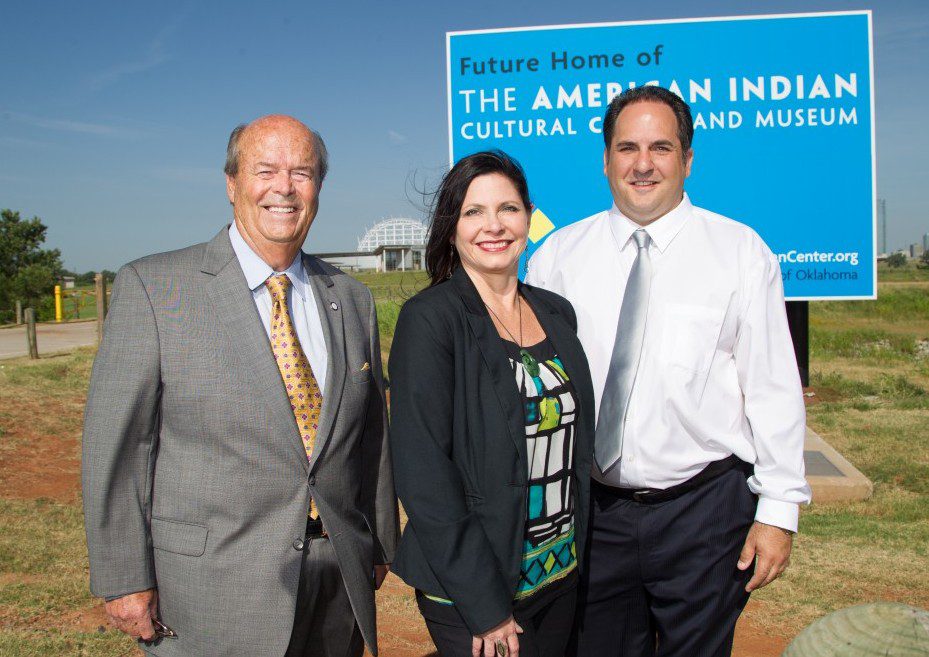
The Center’s original funding plan was built on an assumption of federal assistance. Two U.S. senators and four U.S. congressmen assured the state that Uncle Sam would pick up one-third of the tab. The state put its chips down. Private contributors, tribes and the City of Oklahoma City pulled seats up to the table. Construction began. Three years passed, and it became clear that the federal government had no interest. By 2008, the waiting got old. The Oklahoma senate approved $25 million in bond funding to keep the project going.
Then there’s good, old-fashioned caprice. Hurricane Katrina slammed into the Gulf of Mexico, blowing construction costs through the roof across the nation. In 2008 the country began a long slide into the deepest recession since the Great Depression. The cost of everything rose, and funds fell short.
Critics have levied charges of fraud, abuse and wastefulness against AICCM. Accusations of suspect bid selection popped up here and there. In an effort to quash rumors and end the finger-pointing, Gov. Mary Fallin called in the Oklahoma State Auditor and Inspectors Office. The final verdict: the AICCM is squeaky clean. It’s shown complete fiscal responsibility while dealing with uncontrollable outside forces and setback after setback with funding.
“Critics say that the Devon Tower was built for less and in a fraction of the time. It’s true,” says Loveless. “Funds for the entire building were in place before construction started. That makes things move quicker and cheaper. The AICCM didn’t have that, and it’s a project shared by three levels of government, several tribes and outside contributors. Funding shortfalls, coordination of so many agencies, and some bad luck. It’s not hard to see why it’s taken so long.”
Loveless and Wade are hopeful. They used the 2013 legislative session productively, capturing lost ground. The newest proposal in front of the legislature calls for a funding package split over three years. It was scheduled for a vote at the end of the recent legislative session, but once again the AICCM found itself at the mercy of outside forces. The tornados in Moore and Shawnee hit, and the legislature rightly gave the matter its full attention. Senate Pro Tem Brian Bingman and House Speaker T.W. Shannon, however, have agreed to postpone the vote until early in the 2014 session. The move is a little unconventional, but the bill has made its way through committees and is ready to go.
For now, the only visitors the Center sees are the maintenance men that routinely check the facility’s core systems and security guards that stand watch around the clock. Bitter AICCM supporters point to the uncompleted facility as another broken promise. Those willing to fight on do so without rancor, tirelessly explaining the importance –economic and cultural – of AICCM and carefully putting the pieces in place to ensure its survival. And many legislators that opposed the Center’s funding in the past are comfortable with the new plan or are at least willing to approach it with an open mind. The smart money says, despite the arduous road getting there, the doors of the AICCM will swing open, Oklahoma will see an unprecedented tourism windfall and the state’s rich Native American legacy will be have a fitting monument.
Moksha
Saturday, July 27, 7 p.m.
Experiencing India’s culture is a dream that many of us have. Most likely the long hours on the plane and the large amount of money needed for the trip is what’s stopping our dreams. Thankfully, on Saturday, July 27, the Tulsa Performing Arts Center Trust and the Sanskriti School of Dance is bringing a little bit of that culture to Oklahoma for one night. Moksha, which means “liberation,” is a show created from the mind of classical Bharatanatyam artist Vidhya Subramanian. She and her students combine modern subjects with the elegant, ages-old Indian dance form Bharatanatyam. The performance will be at the John H. Williams Theatre of the Tulsa Performing Arts Center, 110 E. Second St. Tickets are $10 for children and $12 for adults. Curtain opens at 7 p.m. Purchase tickets at www.myticketoffice.com.
Oklahoma Aquarium’s 10 Year Anniversary Celebration
The Weekend
The Oklahoma Aquarium in Jenks celebrates ten years of conservation, education and memories with two days of events featuring ocean explorer Jean-Michel Cousteau. On Friday, July 26, there will be a patron reception, dinner and program with Cousteau. The event begins at 5:30 p.m. with individual tickets beginning at $150. Saturday is all about families and fun. At 10:30 a.m. Saturday, July 27, Cousteau will talk about his amazing career (undoubtedly influenced by his father, the legendary Jacques Cousteau) and about preserving the oceans and marine life. General admission for this presentation is $9.95 for children and $13.95 for adults. All events will be held at the Oklahoma Aquarium, 300 Aquarium Drive. Saturday’s event will in the aquarium’s Great Hall. Visit www.okaquarium.org for more information.
King John
Thursday, July 25-Sunday, July 28
Oklahoma Shakespeare in the Park presents another Shakespeare masterpiece in Oklahoma City. The Life and Death of King John tells the story of the reign of King John of England, youngest son of King Henry II. Controversy comes his way when France’s King Philip orders King John to step down from the throne to let his nephew, Prince Arthur, rule. A war ensues. While King John defends his title, he learns more of his family and more about himself. From Thursday, July 25-Sunday, July 28, King John will be performed at Oklahoma City University’s Burg Theatre, located in the Kirkpatrick Fine Arts Center, 2501 N. Blackwelder. The drama begins at 8 p.m. Thursday-Saturday and at 2:30 p.m. Sunday. Tickets are $10-$15 and can be purchased at www.oklahomashakespeare.com.
61st Annual Tulsa Powwow
Friday, July 26-Sunday, July 28
One of the great perks of living in Oklahoma is that we Oklahomans get to see the beauty of the Native American culture and history first hand. The Tulsa Powwow is one of those perks. Friday, July 26-Sunday, July 28, marks the 61st Annual Tulsa Powwow at the Spirit Bank Event Center, 10441 S. Regal Blvd. At this event hosted by the Tulsa Indian Club, people of all nations come together to celebrate. The weekend will be full of traditional powwow dances and music led by the master of ceremonies, Wallace Coffey. Come watch as contestants of all ages show their native pride. Many vendors will also be there selling arts and crafts, food and more. Festivities start at 5 p.m. on Friday and at 1 p.m. on Saturday and Sunday. Admission is $5 per day. Children under 5 years old are free. For more, see www.tulsapowwow.org.



